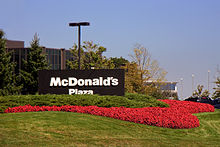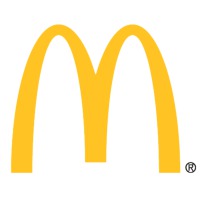
福布斯世界品牌排行榜 – 第七名- 美国麦当劳
Top 100 Brand In the World by Forbes – Rank no.7 – McDonald’s US
Market Cap $99.95 B
At a Glance
- Industry: Restaurants
- Founded: 1955
- Country: United States
- CEO: Donald Thompson
- Website: www.mcdonalds.com
- Employees: 440,000
- Sales: $27.57 B
- Headquarters: Oak Brook, Illinois
Forbes Lists
- #344 in Sales
- #106 in Profit
- #637 in Assets
- #61 in Market value
Profile
McDonald’s Corporation franchises and operates McDonald’s restaurants in the global restaurant industry. These restaurants serve a menu at various price points providing value in 119 countries globally. As of December 31, 2011, of the 33,510 restaurants in 119 countries 27,075 were franchised or licensed (including 19,527 franchised to conventional franchisees, 3,929 licensed to developmental licensees and 3,619 licensed to foreign affiliates (affiliates)-primarily Japan) and 6,435 were operated by the Company. McDonald’s menu includes hamburgers and cheeseburgers, Big Mac, Quarter Pounder with Cheese, Filet-O-Fish, several chicken sandwiches, Chicken McNuggets, Snack Wraps, French fries, salads, oatmeal, shakes, McFlurry desserts, sundaes, soft serve cones, pies, soft drinks, coffee, McCafe beverages and other beverages.
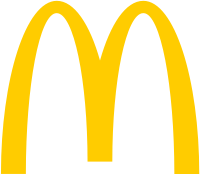 |
|
| Type | Public |
|---|---|
| Traded as | NYSE: MCD Dow Jones Industrial Average Component S&P 500 Component |
| Industry | Restaurants |
| Founded | May 15, 1940 in San Bernardino, California; McDonald’s Corporation, April 15, 1955 in Des Plaines, Illinois |
| Founder(s) | Richard and Maurice McDonaldMcDonald’s restaurant concept; Ray Kroc, McDonald’s Corporation founder. |
| Headquarters | Oak Brook, Illinois, U.S. |
| Number of locations | 34,000+ worldwide[1] |
| Area served | Worldwide |
| Key people | Andrew J. McKenna (Chairman) Don Thompson (President and CEO) |
| Products | Fast food (hamburgers • chicken • french fries • soft drinks • coffee •milkshakes • salads •desserts • breakfast) |
| Revenue | |
| Operating income | |
| Net income | |
| Total assets | |
| Total equity | |
| Employees | 1,800,000 (2013) [3] |
| Website | Global Corporate Website |
The McDonald’s Corporation (NYSE: MCD) is the world’s largest chain of hamburger fast food restaurants, serving around 68 million customers daily in 119 countries.[4][5] Headquartered in the United States, the company began in 1940 as a barbecue restaurant operated by Richard and Maurice McDonald; in 1948 they reorganized their business as a hamburger stand using production line principles. Businessman Ray Kroc joined the company as a franchise agent in 1955. He subsequently purchased the chain from the McDonald brothers and oversaw its worldwide growth.[6]
A McDonald’s restaurant is operated by either a franchisee, an affiliate, or the corporation itself. McDonald’s Corporation revenues come from the rent, royalties, and fees paid by the franchisees, as well as sales in company-operated restaurants. In 2012, McDonald’s Corporation had annual revenues of $27.5 billion, and profits of $5.5 billion.[7]
McDonald’s primarily sells hamburgers, cheeseburgers, chicken, french fries, breakfast items, soft drinks, milkshakes, and desserts. In response to changing consumer tastes, the company has expanded its menu to include salads, fish, wraps, smoothies, and fruit.
History

The oldest operating McDonald’s restaurant was the third one built, opening in 1953. It is located at 10207 Lakewood Blvd. at Florence Ave. in Downey, California (at33.9471°N 118.1182°W).
The business began in 1940, with a restaurant opened by brothers Richard and Maurice McDonald at 1398 North E Street at West 14th Street in San Bernardino, California (at34.1255°N 117.2946°W). Their introduction of the “Speedee Service System” in 1948 furthered the principles of the modern fast-food restaurant that the White Castle hamburger chain had already put into practice more than two decades earlier. The original mascot of McDonald’s was a man with a chef’s hat on top of a hamburger shaped head whose name was “Speedee”. Speedee was eventually replaced with Ronald McDonald by 1967 when the company first filed a U.S. trademark on a clown shaped man having puffed out costume legs.
McDonald’s first filed for a U.S. trademark on the name “McDonald’s” on May 4, 1961, with the description “Drive-In Restaurant Services”, which continues to be renewed through the end of December 2009. In the same year, on September 13, 1961, the company filed a logo trademark on an overlapping, double arched “M” symbol. The overlapping double arched “M” symbol logo was temporarily disfavored[clarification needed] by September 6, 1962, when a trademark was filed for a single arch, shaped over many of the early McDonald’s restaurants in the early years. Although the “Golden Arches” appeared in various forms, the present form as a letter “M” did not appear until November 18, 1968, when the company applied for a U.S. trademark. The present corporation dates its founding to the opening of a franchised restaurant by Ray Kroc, in Des Plaines, Illinois, on April 15, 1955, the ninth McDonald’s restaurant overall. Kroc later purchased the McDonald brothers’ equity in the company and led its worldwide expansion, and the company became listed on the public stock markets in 1965.Kroc was also noted for aggressive business practices, compelling the McDonald brothers to leave the fast food industry. The McDonald brothers and Kroc feuded over control of the business, as documented in both Kroc’s autobiography and in the McDonald brothers’ autobiography. The San Bernardino store was demolished in 1976 (or 1971, according to Juan Pollo) and the site was sold to the Juan Pollo restaurant chain. It now serves as headquarters for the Juan Pollo chain, as well as a McDonald’s and Route 66 museum.[9] With the expansion of McDonald’s into many international markets, the company has become a symbol of globalization and the spread of the American way of life. Its prominence has also made it a frequent topic of public debates about obesity, corporate ethics and consumer responsibility.
Headquarters
The McDonald’s headquarters complex, McDonald’s Plaza, is located in Oak Brook, Illinois. It sits on the site of the former headquarters and stabling area of Paul Butler, the founder of Oak Brook.[10] McDonald’s moved into the Oak Brook facility from an office within theChicago Loop in 1971.[11]
Products
McDonald’s predominantly sells hamburgers, various types of chicken sandwiches and products, French fries, soft drinks, breakfastitems, and desserts. In most markets, McDonald’s offers salads and vegetarian items, wraps and other localized fare. On a seasonal basis, McDonald’s offers the McRib sandwich. Some speculate the seasonality of the McRib adds to its appeal.[12] Various countries, especially in Asia, are currently serving soup. This local deviation from the standard menu is a characteristic for which the chain is particularly known, and one which is employed either to abide by regional food taboos (such as the religious prohibition of beef consumption in India) or to make available foods with which the regional market is more familiar (such as the sale of McRice inIndonesia). In Germany and other Western European countries, McDonald’s sells beer.
Corporate overview
Facts and figures
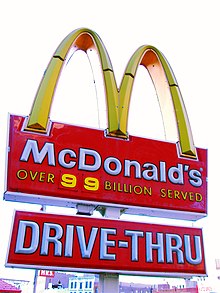
By 1993, McDonald’s had sold more than 100 billion hamburgers. The once widespread restaurant signs that boasted the number of sales, such as this one inHarlem, were left at “99 billion” because there was only space for two digits.
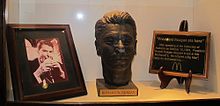
The McDonald’s in Northport, Alabamacommemorates President Ronald Reagan’s visit.
McDonald’s restaurants are found in 119 countries[13] and territories around the world and serve 68 million customers each day.[4]McDonald’s operates over 34,000 restaurants worldwide, employing more than 1.7 million people.[13] The company also operates other restaurant brands, such as Piles Café.
Focusing on its core brand, McDonald’s began divesting itself of other chains it had acquired during the 1990s. The company owned a majority stake in Chipotle Mexican Grill until October 2006, when McDonald’s fully divested from Chipotle through a stock exchange.[14][15] Until December 2003, it also owned Donatos Pizza. On August 27, 2007, McDonald’s sold Boston Market to Sun Capital Partners.[16]
Notably, McDonald’s has increased shareholder dividends for 25 consecutive years,[17] making it one of the S&P 500 Dividend Aristocrats.[18][19] In October 2012, its monthly sales fell for the first time in nine years.[20]
Types of restaurants
Most standalone McDonald’s restaurants offer both counter service and drive-through service, with indoor and sometimes outdoor seating. Drive-Thru, Auto-Mac, Pay and Drive, or “McDrive” as it is known in many countries, often has separate stations for placing, paying for, and picking up orders, though the latter two steps are frequently combined; it was first introduced in Arizona in 1975, following the lead of other fast-food chains. The first such restaurant in Britain opened at Fallowfield, Manchester in 1986.[21]

A Montevideo McCafé
In some countries, “McDrive” locations near highways offer no counter service or seating. In contrast, locations in high-density city neighborhoods often omit drive-through service. There are also a few locations, located mostly in downtown districts, that offer Walk-Thru service in place of Drive-Thru.
To accommodate the current trend for high quality coffee and the popularity of coffee shops in general, McDonald’s introduced McCafé, acafé-style accompaniment to McDonald’s restaurants in the style of Starbucks. McCafé is a concept created by McDonald’s Australia, starting with Melbourne in 1993. Today, most McDonald’s in Australia have McCafés located within the existing McDonald’s restaurant. InTasmania, there are McCafés in every store, with the rest of the states quickly following suit. After upgrading to the new McCafé look and feel, some Australian stores have noticed up to a 60% increase in sales. As of the end of 2003 there were over 600 McCafés worldwide.
Some locations are connected to gas stations/convenience stores,[22] while others called McExpress have limited seating and/or menu or may be located in a shopping mall. Other McDonald’s are located in Walmart stores. McStop is a location targeted at truckers and travelers which may have services found at truck stops.[23]
Since 1997, the only Kosher McDonald’s in the world that is not in Israel, is located in theAbasto mall, in Buenos Aires, Argentina.[24][25]
Global operations

A McDonald’s in Buenos Aires,Argentina
McDonald’s has become emblematic of globalization, sometimes referred to as the “McDonaldization” of society. The Economist newspaper uses the “Big Mac Index“: the comparison of a Big Mac‘s cost in various world currencies can be used to informally judge these currencies’ purchasing power parity. Norway has the most expensive Big Mac in the world as of July 2011, while the country with the least expensive Big Mac is India[26] (albeit for a Maharaja Mac—the next cheapest Big Mac is Hong Kong).[27]
Thomas Friedman once said that no country with a McDonald’s had gone to war with another.[28][full citation needed] However, the “Golden Arches Theory of Conflict Prevention” is not strictly true. Exceptions are the 1989 United States invasion of Panama, NATO’s bombing of Serbia in 1999, the 2006 Lebanon War, and the 2008 South Ossetia war.

A McDonald’s with a playground inZwolle, Netherlands
Some observers have suggested that the company should be given credit for increasing the standard of service in markets that it enters. A group of anthropologists in a study entitled Golden Arches East[29] looked at the impact McDonald’s had on East Asia, and Hong Kong in particular. When it opened in Hong Kong in 1975, McDonald’s was the first restaurant to consistently offer clean restrooms, driving customers to demand the same of other restaurants and institutions. McDonald’s has taken to partnering up with Sinopec, the second largest oil company in the People’s Republic of China, as it takes advantage of the country’s growing use of personal vehicles by opening numerous drive-thru restaurants.[30] McDonald’s has opened a McDonald’s restaurant and McCafé on the underground premises of the Frenchfine arts museum, The Louvre.[31]
The company stated it will open vegetarian-only restaurants in India by mid-2013.[32]
Playgrounds

McDonald’s in Panorama City, Los Angeles, California designed for family-friendly image.
Some McDonald’s in suburban areas and certain cities feature large indoor or outdoorplaygrounds. The first PlayPlace with the familiar crawl-tube design with ball pits and slides was introduced in 1987 in the USA, with many more being constructed soon after. Some PlayPlace playgrounds have been renovated into “R Gym” areas.
Redesign
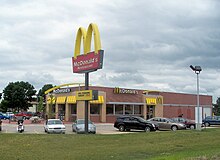
An American McDonald’s in Mount Pleasant, Iowa in June 2008; this is an example of the “new” look of American McDonald’s restaurants.
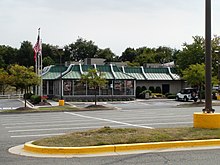
An American McDonald’s inGermantown, Maryland in September 2013.

An Irish McDonald’s in Port Laoise,County Laois, Ireland in August 2012; this is a relatively modern restaurant complete with a drive-through.
In 2006, McDonald’s introduced its “Forever Young” brand by redesigning all of its restaurants, the first major redesign since the 1970s.[33][34] McDonald’s has invested $1 billion to redesign nearly all of the 14,000 restaurants by 2015.
The goal of the redesign is to be more like a coffee shop, similar to Starbucks. The design includes wooden tables, faux-leather chairs, and muted colors; the red was muted to terra cotta, the yellow was turned golden for a more “sunny” look, and olive and sage green were also added. To warm up its look, the restaurants have less plastic and more brick and wood, with modern hanging lights to produce a softer glow. Many restaurants now feature free Wi-Fiand flat screen TVs. Other upgrades include double drive-thrus, flat roofs instead of the angled red roofs, and replacing fiber glass with wood. Also, instead of the familiar golden arches, the restaurants now feature “semi-swooshes” (half of a golden arch), similar to the Nike swoosh.[35]
Business model
McDonald’s Corporation earns revenue as an investor in properties, a franchiser of restaurants, and an operator of restaurants. Approximately 15% of McDonald’s restaurants are owned and operated by McDonald’s Corporation directly. The remainder are operated by others through a variety of franchise agreements and joint ventures.
The McDonald’s Corporation’s business model is slightly different from that of most other fast-food chains. In addition to ordinaryfranchise fees and marketing fees, which are calculated as a percentage of sales, McDonald’s may also collect rent, which may also be calculated on the basis of sales. As a condition of many franchise agreements, which vary by contract, age, country, and location, the Corporation may own or lease the properties on which McDonald’s franchises are located. In most, if not all cases, the franchisee does not own the location of its restaurants.
The United Kingdom and Ireland business model is different than the U.S, in that fewer than 30% of restaurants are franchised, with the majority under the ownership of the company. McDonald’s trains its franchisees and others at Hamburger University in Oak Brook,Illinois.
In other countries, McDonald’s restaurants are operated by joint ventures of McDonald’s Corporation and other, local entities or governments.
As a matter of policy, McDonald’s does not make direct sales of food or materials to franchisees, instead organizing the supply of food and materials to restaurants through approved third party logistics operators.
According to Fast Food Nation by Eric Schlosser (2001), nearly one in eight workers in the U.S. have at some time been employed by McDonald’s. The book also states that McDonald’s is the largest private operator of playgrounds in the U.S., as well as the single largest purchaser of beef, pork, potatoes, and apples. The selection of meats McDonald’s uses varies to some extent based on the culture of the host country.
Advertising
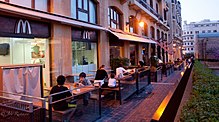
McDonald’s branch in Beirut Central District
McDonald’s has for decades maintained an extensive advertising campaign. In addition to the usual media (television, radio, and newspaper), the company makes significant use of billboards and signage, sponsors sporting events ranging from Little League to the Olympic Games, and makes coolers of orange drinkwith its logo available for local events of all kinds. Nonetheless, television has always played a central role in the company’s advertising strategy.
To date, McDonald’s has used 23 different slogans in United States advertising[citation needed], as well as a few other slogans for select countries and regions. At times, it has run into trouble with its campaigns.
Space exploration
McDonald’s and NASA explored an advertising agreement for a planned mission to the asteroid 449 Hamburga; however, the spacecraft was eventually cancelled.[36]
Children’s advertising
Sports awards and honors
Charity
McHappy Day
McHappy Day is an annual event at McDonald’s, where a percentage of the day’s sales go to charity. It is the signature fundraising event for Ronald McDonald House Charities.[37]
In 2007, it was celebrated in 17 countries: Argentina, Australia, Austria, Brazil, Canada, the United States, Finland, France, Guatemala,Hungary, England, Ireland, New Zealand, Norway, Sweden, Switzerland and Uruguay.
According to the Australian McHappy Day web site, McHappy Day raised $20.4 million in 2009. The goal for 2010 was $20.8 million.[38]
McDonald’s Monopoly donation to St. Jude
In 1995, St. Jude Children’s Research Hospital received an anonymous letter postmarked in Dallas, Texas, containing a $1 million winning McDonald’s Monopoly game piece. McDonald’s officials came to the hospital, accompanied by a representative from the accounting firm Arthur Andersen, who examined the card under a jeweler’s eyepiece, handled it with plastic gloves, and verified it as a winner.[39] Although game rules prohibited the transfer of prizes, McDonald’s waived the rule and has made the annual $50,000 annuity payments, even after learning that the piece was sent by an individual involved in an embezzlement scheme intended to defraud McDonald’s (see McDonald’s Monopoly).
Criticism
As a prominent example of the rapid globalization of the American fast food industry, McDonald’s is often the target of criticism for its menu, its expansion, and its business practices. The McLibel Trial, also known as McDonald’s Restaurants v Morris & Steel, is an example of this criticism. In 1990, activists from a small group known as London Greenpeace (no connection to the international group Greenpeace) distributed leaflets entitled What’s wrong with McDonald’s?, criticizing its environmental, health, and labor record. The corporation wrote to the group demanding they desist and apologize, and, when two of the activists refused to back down, sued them for libel in one of the longest cases in British civil law. A documentary film of the McLibel Trial has been shown in several countries.
Despite the objections of McDonald’s, the term “McJob” was added to Merriam-Webster’s Collegiate Dictionary in 2003.[40] The term was defined as “a low-paying job that requires little skill and provides little opportunity for advancement”.[41]
In 2001, Eric Schlosser‘s book Fast Food Nation included criticism of the business practices of McDonald’s. Among the critiques were allegations that McDonald’s (along with other companies within the fast food industry) uses its political influence to increase its profits at the expense of people’s health and the social conditions of its workers. The book also brought into question McDonald’s advertisement techniques in which it targets children. While the book did mention other fast-food chains, it focused primarily on McDonald’s.
In 2002, vegetarian groups, largely Hindu and Buddhist, successfully sued McDonald’s for misrepresenting its French fries as vegetarian, when they contained beef broth.[42]
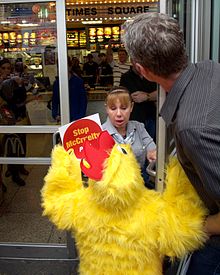
A PETA activist dressed as a chicken confronts the manager of the Times SquareMcDonald’s over the company’s animal welfare standards.
Morgan Spurlock‘s 2004 documentary film Super Size Me said that McDonald’s food was contributing to the epidemic of obesity in society, and that the company was failing to provide nutritional information about its food for its customers. Six weeks after the film premiered, McDonald’s announced that it was eliminating the super size option, and was creating the adult Happy Meal.
Arguments in defense
In response to public pressure, McDonald’s has sought to include more healthy choices in its menu and has introduced a new slogan to its recruitment posters: “Not bad for a McJob“.[43] (The word McJob, first attested in the mid-1980s[44] and later popularized by Canadian novelist Douglas Coupland in his book Generation X, has become a buzz word for low-paid, unskilled work with few prospects or benefits and little security.) McDonald’s disputes this definition of McJob. In 2007, the company launched an advertising campaign with the slogan “Would you like a career with that?” on Irish television, outlining that its jobs have many prospects.
In an effort to respond to growing consumer awareness of food provenance, the fast-food chain changed its supplier of both coffee beansand milk. UK chief executive Steve Easterbrook said: “British consumers are increasingly interested in the quality, sourcing and ethics of the food and drink they buy”.[45] In a bid to tap into the ethical consumer market,[46] McDonald’s switched to using coffee beans taken from stocks that are certified by the Rainforest Alliance, a conservation group. Additionally, in response to pressure, McDonald’s UK started using organic milk supplies for its bottled milk and hot drinks, although it still uses conventional milk in its milkshakes, and in all of its dairy products in the United States.[47] According to a report published by Farmers Weekly in 2007, the quantity of milk used by McDonald’s could have accounted for as much as 5% of the UK’s organic milk output.[48]
McDonald’s announced on May 22, 2008 that, in the United States and Canada, it would switch to using cooking oil that contains notrans fats for its french fries, and canola-based oil with corn and soy oils, for its baked items, pies and cookies, by year’s end.[49][50]
With regard to acquiring chickens from suppliers who use CAK or CAS methods of slaughter, McDonald’s says that it needs to see more research “to help determine whether any CAS system in current use is optimal from an animal welfare perspective.”[51]
Environmental record

Kosher McDonald’s at Ben Gurion Airport, Israel
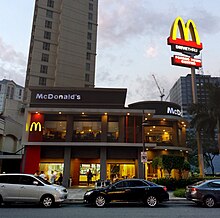
McDonald’s at Rizal Drive, corner 26th Street, Bonifacio Global City, Metro Manila,Philippines.
In April 2008, McDonald’s announced that 11 of its Sheffield, England restaurants have been using a biomass trial that had cut its waste and carbon footprint by half in the area. In this trial, wastes from the restaurants were collected by Veolia Environmental Services, and were used to produce energy at a power plant. McDonald’s plans to expand this project, although the lack of biomass power plants in the United States will prevent this plan from becoming a national standard anytime soon.[52] In addition, in Europe, McDonald’s has been recycling vegetable grease by converting it to fuel for its diesel trucks.[53]
Furthermore, McDonald’s has been using a corn-based bioplastic to produce containers for some of its products. Although industries who use this product claim a carbon savings of 30% to 80%, a Guardian study shows otherwise. The results show that this type of plastic does not break down in landfills as efficiently as other conventional plastics. The extra energy it takes to recycle this plastic results in a higher output of greenhouse gases. Also, the plastics can contaminate waste streams, causing other recycled plastics to become unsaleable.[54]
The U.S. Environmental Protection Agency has recognized McDonald’s continuous effort to reduce solid waste by designing more efficient packaging and by promoting the use of recycled-content materials.[55] McDonald’s reports that it is committed towards environmental leadership by effectively managing electric energy, by conserving natural resources through recycling and reusing materials, and by addressing water management issues within the restaurant.[56]
In an effort to reduce energy usage by 25% in its restaurants, McDonald’s opened a prototype restaurant in Chicago in 2009 with the intention of using the model in its other restaurants throughout the world. Building on past efforts, specifically a restaurant it opened in Sweden in 2000 that was the first to intentionally incorporate green ideas, McDonald’s designed the Chicago site to save energy by incorporating old and new ideas such as managing storm water, using skylights for more natural lighting and installing some partitions and tabletops made from recycled goods.[57]
When McDonald’s received criticism for its environmental policies in the 1970s, it began to make substantial progress towards source reductions efforts.[58] For instance, an “average meal” in the 1970s—a Big Mac, fries, and a drink—required 46 grams of packaging; today, it requires only 25 grams, allowing a 46% reduction.[59] In addition, McDonald’s eliminated the need for intermediate containers forcola by having a delivery system that pumps syrup directly from the delivery truck into storage containers, saving two million pounds of packaging annually.[60] Overall, weight reductions in packaging and products, as well as the increased usage of bulk packaging ultimately decreased packaging by 24 million pounds annually.[61]
Legal cases
McDonald’s has been involved in a number of lawsuits and other legal cases, most of which involved trademark disputes. The company has threatened many food businesses with legal action unless it drops the Mc or Mac from trading names. In one noteworthy case, McDonald’s sued a Scottish café owner called McDonald, even though the business in question dated back over a century (Sheriff Court Glasgow and Strathkelvin, November 21, 1952). On September 8, 2009, McDonald’s Malaysian operations lost a lawsuit to prevent another restaurant calling itself McCurry. McDonald’s lost in an appeal to Malaysia’s highest court, the Federal Court.[62]
It has also filed numerous defamation suits. For example, in the McLibel case, McDonald’s sued two activists for distributing pamphlets attacking its environmental, labor and health records. After the longest trial in UK legal history, the judge found that some claims in the pamphlet were untrue and therefore libelous. The company, however, had asserted that all claims in the pamphlet were untrue, essentially obliging the judge to publicly rule on each one. A few of the specific allegations (specifically that McDonald’s was “culpably responsible” for animal cruelty, that it exploited children through its advertising, and that it paid low wages) were found to be true.[63]
McDonald’s has defended itself in several cases involving workers’ rights. In 2001, the company was fined £12,400 by British magistrates for illegally employing and over-workingchild labor in one of its London restaurants. This is thought to be one of the largest fines imposed on a company for breaking laws relating to child working conditions (R v 2002 EWCA Crim 1094). In April 2007, in Perth, Western Australia, McDonald’s pleaded guilty to five charges relating to the employment of children under 15 in one of its outlets and was fined A$8,000.[64]
Possibly the most infamous legal case involving McDonald’s was the 1994 decision in Liebeck v. McDonald’s Restaurants where Stella Liebeck was awarded several million dollars after she suffered third-degree burns after spilling a scalding cup of McDonald’s coffee on herself.[65]
In a McDonald’s American Idol figurine promotion, the figurine that represents “New Wave Nigel” wears something that closely resembles Devo’s Energy dome, which was featured on the band’s album cover, Freedom of Choice. In addition to the figurine’s image, it also plays a tune that appears to be an altered version of Devo’s song “Doctor Detroit“. Devo copyrighted and trademarked the Energy Dome and is taking legal action against McDonald’s.[66]
Employment practices
On 5 August 2013, The Guardian revealed that 90% of McDonalds UK workforce are on zero hour contracts, making it possibly the largest such private sector employer in the country.[67]
A Study released by Fast Food Foreward conducted by Anzalone Liszt Grove Research showed that approximately 84% of all fast food employees working in New York City in April 2013 had been paid less than their legal wages by their employers.[68]
See also
- Burger King—the second largest burger chain
- Wendy’s—third largest hamburger chain
- MaDonal—a restaurant knock-off operating in Northern Iraq
- Maxime, McDuff & McDo, documentary film about the unionizing of a McDonald’s in Montreal, Quebec, Canada


